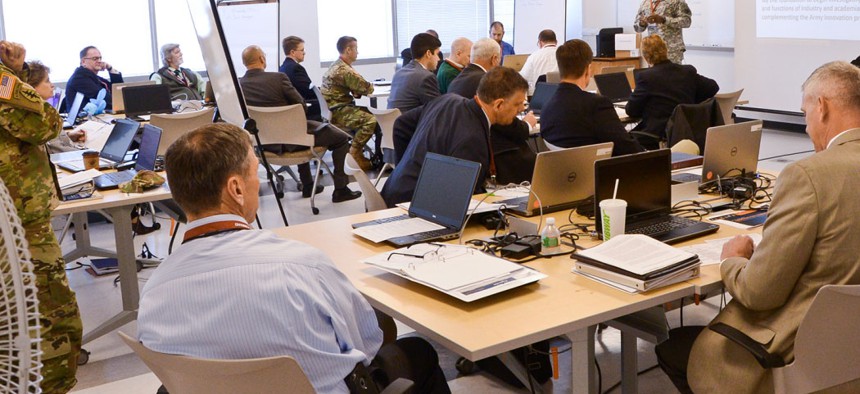
ARL looks west to spur innovation
The Army Research Lab is following the lead of the Defense Department and establishing an office on the West Coast to link up with the tech sector.
The Army Research Laboratory, looking to boost innovation among its ranks, is looking to engage industry as a way to help keep up with the pace of change in technology. An innovation summit this month gathered members of the military, civilian leaders, scientists and engineers from various organizations within the Army to share ideas, while ARL also said it was establishing an office on the West Coast.
“We live in a complex world with complex threats,” said Maj. Gen. John F. Wharton, commanding general of the U.S. Army Research, Development and Engineering Command. “To recommend innovative solutions, we must prioritize our needs.”
Wharton noted that innovation is a key component of the Defense Department’s Third Offset Strategy, to which looks to bring advances made in the commercial world into the military. “The Army Operating Concept defines innovation as the result of critical and creative thinking and the conversion of new ideas into valued outcomes,” he said.
“The world has been changing over the last two decades,” Assistant Secretary of Defense for Research and Engineering Stephen Welby said at the summit, which was held at Aberdeen Proving Ground, Md. “The pace of change is visible in all of our daily lives. We see it in technology. We see it in business. We see it in the globalization of talent and technology. We see it shifting in terms of the nature of the threat we face in the future.”
The first innovation summit, hosted in November, focused on concepts and requirements, identifying barriers to innovation and developing ideas to break them down.
“The quarterly innovation summit program is a core component of the Army's Innovation Campaign and an important medium for Army senior leader discussions,” Wharton said. “This is an opportunity to build upon the knowledge and insight gained during the first summit and discover new opportunities to refine solutions that will enhance Army innovation.”
“Innovation does not come from technology alone,” Welby said. “It emerges from evolutionary problem-solving directed at specific operational and tactical issues. It requires coherent frameworks of doctrine and concepts.”
“Today technology moves real quickly and we’re in conflict today – we’re in the conflict with ISIL as we speak…we’re in a competitive situation as with China and Russia, for example. They’re innovating every day,” Defense Secretary Ashton Carter, using an alternate acronym for ISIS, said at a March breakfast hosted by Politico. “And [Russia and China] live out there as we do in a world where a lot of technology doesn’t come from us. It comes from the commercial world and we need to feed upon that. And that’s rapidly changing. So for those two reasons – the immediacy of the possibility of conflict and the need to react quickly and also the pace at which technology changes – I have to challenge our folks to get faster.”
One of the efforts aimed at both bolstering innovation and bridging this commercial-military gap is the establishment of the Defense Innovation Unit Experimental (DIUx), the Defense Department’s new Silicon Valley satellite office intended to encourage collaboration between the military and technology communities. The Army Research Lab has recently linked onto this effort, establishing “ARL West,” described as “a new West Coast science and technology presence for the Army.” Earlier this month, ARL stopped by DIUx to give a briefing on its efforts.
ARL West is part of ARL’s Open Campus initiative to co-locate Army research and development personnel on the West Coast as a means of syncing with the technical experts that might not exist in as great numbers on the East Coast. “Closer collaboration with universities, start-ups and established companies working in simulation and training, electronics, information science, intelligent systems, human-system interaction, etc. will directly benefit the soldier,” the Army said.
According to a presentation at ARL West’s launch, its goals serve to facilitate generation, identification and harvesting of technology opportunities, create a west coast collaborative innovation hub to solve Army problems and access to large pool of subject matter experts.
Additionally, ARL West has four major research areas:
- Contextual analysis, focusing on context-aware analytics and resource management.
- Hybrid interfaces, focusing on naturalistic and mixed reality human interfaces.
- Integrated analysis and assessment, focusing on assessment and analysis of decision making.
- Joint decisions, focusing on novel forms of joint human-agent decision making.
The effort also hones in on several campaigns such as analysis and assessment, computational sciences, human sciences, information sciences, materials research and sciences for maneuver – all seeking to understand methodologies, technologies and operations in a variety of sectors such as cyber, electromagnetic spectrum, sensors, networks and communications, to name a few.